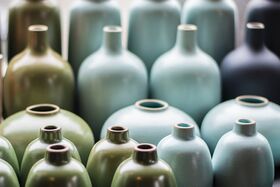- v50 information can now be added to pages in the main namespace. v0.47 information can still be found in the DF2014 namespace. See here for more details on the new versioning policy.
- Use this page to report any issues related to the migration.
Difference between revisions of "Ceramic"
m (to be clear) |
|||
| Line 4: | Line 4: | ||
A '''ceramic''' is an inorganic, non-metallic solid prepared by the action of heat and subsequent cooling. In Dwarf Fortress, there are 3 types of ceramic materials - [[earthenware]], [[stoneware]], and [[porcelain]]. | A '''ceramic''' is an inorganic, non-metallic solid prepared by the action of heat and subsequent cooling. In Dwarf Fortress, there are 3 types of ceramic materials - [[earthenware]], [[stoneware]], and [[porcelain]]. | ||
| − | Ceramic goods are produced at the [[kiln]] using [[fuel]] with either [[clay]]/[[clay loam]]/[[sandy clay]]/[[silty clay]] (earthenware), [[fire clay]] (stoneware), or [[kaolinite]] (porcelain). A [[magma kiln]] can also be used, in which case no fuel is required. | + | Ceramic goods are produced at the [[kiln]] using [[fuel]] with either [[clay]]/[[clay loam]]/[[sandy clay]]/[[silty clay]] (earthenware), [[fire clay]] (stoneware), or [[kaolinite]] (porcelain). A [[magma kiln]] can also be used, in which case no fuel is required. In Dwarf Fortress, there are no clay products that do not require a kiln. |
Ceramics are [[fire-safe]] but not [[magma-safe]] (melting point: {{ct|11500}}), and [[dragonfire]] is capable of melting and boiling ceramic material. | Ceramics are [[fire-safe]] but not [[magma-safe]] (melting point: {{ct|11500}}), and [[dragonfire]] is capable of melting and boiling ceramic material. | ||
Revision as of 17:55, 21 March 2020
v50.14 · v0.47.05 This article is about the current version of DF.Note that some content may still need to be updated. |
A ceramic is an inorganic, non-metallic solid prepared by the action of heat and subsequent cooling. In Dwarf Fortress, there are 3 types of ceramic materials - earthenware, stoneware, and porcelain.
Ceramic goods are produced at the kiln using fuel with either clay/clay loam/sandy clay/silty clay (earthenware), fire clay (stoneware), or kaolinite (porcelain). A magma kiln can also be used, in which case no fuel is required. In Dwarf Fortress, there are no clay products that do not require a kiln.
Ceramics are fire-safe but not magma-safe (melting point: 11500 °U ), and dragonfire is capable of melting and boiling ceramic material.
Uses
Ceramics can be used to make statues, blocks (labeled as "bricks"), crafts, hives for beekeeping, jugs for storing liquids, and large pots for storing food. Some instruments or instrument parts can be made from ceramic, depending on world generation. Jugs and pots made from earthenware must first be glazed before they can be used to store liquids, while containers made from other materials are naturally resistant to water.
Kaolinite is fairly limited on most maps. You might want to train your potters using clay and save the kaolinite for when your potters have high skill levels. You can do this indirectly by forbidding all of your kaolinite in the Stocks menu, or by linking kilns to stockpiles that don't accept kaolinite.
For more information on the use of ceramic, see the Ceramic industry page.
| More: Gems • Metals • Stones | |
| Creature | |
| Plant | |
| Creature/Plant |
Alcohol • Cloth/Thread • Extract (Golden salve • Gnomeblight • Honey • Royal jelly • Syrup • Venom) • Glob • Liquids • Soap |
| Inorganic |
Metal • Milk of lime • Soil (Clay • Sand) • Stone (Ash glaze • Earthenware • Gem • Gypsum plaster • Porcelain • Quicklime • Stoneware • Tin glaze) |
| Hardcoded | |
| See also: Material science | |
